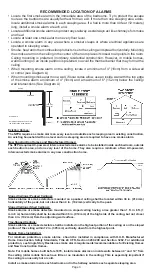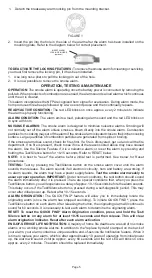
Page 5
OPERATION, TESTING & MAINTENANCE
OPERATION:
The smoke alarm is operating once the battery power is connected by removing the
pull-tab. When products of combustion are sensed, the alarm sounds a loud alarm which continues
until the air is cleared.
This alarm incorporates the NFPA recognized horn signal for evacuation. During alarm mode, the
horn produces three beeps followed by a two second pause and then continually repeats.
READY/ACTIVE CONDITION:
The red LED blinks on once approx. every 2 minutes to indicate
the alarm is properly functioning.
ALARM CONDITION:
The alarm emits a loud, pulsating alarm sound and the red LED blinks on
in sync with horn.
NUISANCE ALARMS:
The smoke alarm is designed to minimize nuisance alarms. Smoking will
not normally set off the alarm unless smoke is blown directly into the smoke alarm. Combustion
particles from cooking may set off the alarm if the smoke alarm is located close to the kitchen cooking
surface. Large quantities of combustion particles are generated from spills or broiling.
If the smoke alarm does sound, check for fires first. If a fire is discovered, get out and call the fire
department. If no fire is present, check to see if one of the reasons listed above may have caused
the alarm. Use the Silence Feature if it is a nuisance alarm, or reset the alarm by pressing and
holding the Test/Silence button for 10-15 seconds. Refer to RESET below.
NOTE:
It is best to "reset" the alarms before initial test is performed. See below for Reset
procedures.
TESTING:
Test by pressing the Test/Silence button on the smoke alarm cover until the alarm
sounds, then release. The alarm sounds if all electronic circuitry, horn and battery are working. If
no alarm sounds, the alarm may have a power supply failure.
Test the smoke alarm weekly to
assure proper operation. IMPORTANT:
Under normal conditions, the test button should sound
the alarm immediately after it is pressed. There are special conditions that, when you press the
Test/Silence button, you will experience a delay of approx. 10-15 seconds before the alarm sounds.
This delay occurs if the Test/Silence button is pressed during a self-diagnostic period. This may
occur after initial power up. Retest after 10-15 seconds.
ALARM ORIGINATION:
The QUICK FIND
®
feature will allow you to immediately locate the
originating alarm (once the alarm has stopped sounding). To initiate QUICK FIND
®
, press the
Test/Silence button on each alarm. After releasing the button, the originating alarm will continue to
sound for 60 seconds. It is necessary to test each alarm to determine the originating alarm.
RESET:
To reset the QUICK FIND
®
Alarm Origination condition, press and hold the Test/
Silence button on any alarm for at least 10-15 seconds and then release. This will clear
alarm origination indicator. Reset after each alarm activation.
END-OF-SERVICE LIFE NOTIFICATION:
A majority of home fire deaths are a result of no smoke
alarms or no
working
smoke alarms. In addition to the "replace by date" stamped on the back of
your alarm, your alarm contains a unique audible end-of-service life notification feature. When it
is time to replace your alarm, which is after approximately 10 years of operation from initial power
up, the alarm will sound 2 chirps approx. every 60 seconds and the red LED will blink on once
approx. every 2 minutes. The alarm should be replaced immediately.
2. Insert the pin into the hole in the side of the alarm after the alarm has been installed on the
mounting plate. Refer to the diagram below for correct placement.
1. Detach the breakaway alarm locking pin from the mounting bracket.
TO DEACTIVATE THE LOCKING FEATURES:
To remove the smoke alarm for cleaning or servicing,
you must first remove the locking pin, if it has been installed.
1. Use long nose pliers to pull the locking pin out of the hole.
2. It is now possible to remove the smoke alarm.
INSERT ALARM
LOCKING PIN HERE
(optional)
FIGURE 1




























